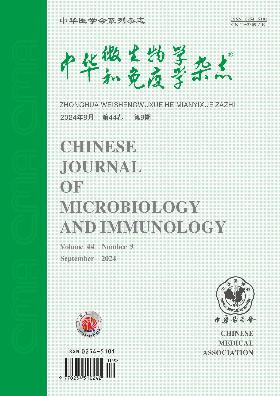CD14+单核细胞HLA-DR异常表达在手足口病患者免疫功能状态及临床预后评估中的价值
Q4 Immunology and Microbiology
引用次数: 0
摘要
目的探讨外周血单核细胞HLA-DR的异常表达对手足口病患者免疫功能状态、临床预后及严重程度的评价价值。方法选取2017年6月~ 2018年10月收治的手足口病轻度患儿100例、重度患儿80例、危重型患儿32例及健康儿童40例(对照组)作为研究对象。根据HLA-DR在单核细胞上的表达情况将患者分为低DR组(DR- l, HLA-DR表达30%)。流式细胞术检测表达HLA-DR的CD14+单核细胞及淋巴细胞亚群绝对计数。采用免疫比浊法检测血浆样品中IgG、IgM和IgA的水平。采用酶联免疫吸附试验(ELISA)检测血浆样品中IFN-γ和IL-10的水平。采用儿童危重疾病评分(PCIS)和儿童死亡风险Ⅲ(PRISMⅢ)来评估手足口病的严重程度。结果①轻、重度、危重型手足口病患儿单核细胞HLA-DR表达差异有统计学意义(F=47.102, P < 0.05)。④与DR-N组比较,DR-L组血浆中IFN-γ水平降低,IL-10水平升高(P<0.05)。DR-L组IFN-γ/IL-10比值低于DR-N组和对照组(P<0.05)。HLA-DR表达与血浆IL-10浓度呈负相关(r=-0.704, P<0.05),与IFN-γ/IL-10比值呈正相关(r=0.773, P<0.05)。⑤与DR-N组比较,DR-L组PCIS较低,PRISM较高Ⅲ。HLA-DR表达与PCIS呈正相关(r=0.715, P=0.00),与PRISMⅢ呈负相关(r=-0.610, P=0.00)。⑥DR-L组手足口病患者肺水肿、肺出血、心肺衰竭发生率及病死率均显著高于DR-N组(P<0.05)。结论重度、危重型手足口病患者存在细胞免疫功能障碍,CD14+单核细胞HLA-DR表达异常。评价HLA-DR在单核细胞上的表达可用于评价重度或危重型手足口病患者的细胞免疫。CD14+单核细胞HLA-DR的低表达可能与严重手足口病和不良预后有关。关键词:手足口病;HLA-DR;细胞免疫本文章由计算机程序翻译,如有差异,请以英文原文为准。
Value of abnormal HLA-DR expression on CD14+ monocytes in estimating immune function status and clinical prognosis of patients with hand, foot and mouth disease
Objective
To investigate the value of abnormal expression of HLA-DR on peripheral blood monocytes in evaluating the immune function status, clinical prognosis and severity of patients with hand, foot and mouth disease (HFMD).
Methods
From June 2017 to October 2018, 100 cases of mild HFMD, 80 cases of severe HFMD, 32 cases of critical HFMD and 40 healthy children (control group) were recruited in this study. The patients were divided into two groups, lower DR group (DR-L, HLA-DR expression 30%) according to the HLA-DR expression on monocytes. Flow cytometry was used to detect the CD14+ monocytes expressing HLA-DR and the absolute count of lymphocyte subsets. Immunoturbidimetry was used to detect the levels of IgG, IgM and IgA in plasma samples. Enzyme-linked immunosorbent assay (ELISA) was performed to detect the levels of IFN-γ and IL-10 in plasma samples. Pediatric critical illness score (PCIS) and the pediatric risk of mortality Ⅲ (PRISM Ⅲ) were used to estimate the severity of HFMD.
Results
① There were significant differences in HLA-DR expression on monocytes among children with mild, severe and critical HFMD (F=47.102, P 0.05). ④ Compared with the DR-N group, the DR-L group showed decreased IFN-γ level and increased IL-10 level in plasma (P<0.05). The ratio of IFN-γ/IL-10 of the DR-L group was lower than that of the DR-N group and control group (P<0.05). HLA-DR expression was negatively correlated with the concentration of IL-10 in plasma (r=-0.704, P<0.05), and positively correlated with the IFN-γ/IL-10 ratio (r=0.773, P<0.05). ⑤ Compared with the DR-N group, the DR-L group showed lower PCIS and higher PRISM Ⅲ. HLA-DR expression was positively correlated with PCIS (r=0.715, P=0.00) and negatively correlated with PRISM Ⅲ (r=-0.610, P=0.00). ⑥ The incidence of pulmonary edema, pulmonary hemorrhage and cardiopulmonary failure and the mortality of HFMD patients in the DR-L group were significantly higher than those in the DR-N group (P<0.05).
Conclusions
Patients with severe or critical HFMD had cellular immune dysfunction and abnormal HLA-DR expression on CD14+ monocytes. Assessing the expression of HLA-DR on monocytes could be used to evaluate the cellular immunity of patients with severe or critical HFMD. Lower expression of HLA-DR on CD14+ monocytes might be associated with severe HFMD and poor prognosis.
Key words:
Hand, foot and mouth disease; HLA-DR; Cellular immunity
求助全文
通过发布文献求助,成功后即可免费获取论文全文。
去求助
来源期刊

中华微生物学和免疫学杂志
Immunology and Microbiology-Virology
CiteScore
0.50
自引率
0.00%
发文量
6906
期刊介绍:
Chinese Journal of Microbiology and Immunology established in 1981. It is one of the series of journal sponsored by Chinese Medical Association. The aim of this journal is to spread and exchange the scientific achievements and practical experience in order to promote the development of medical microbiology and immunology. Its main contents comprise academic thesis, brief reports, reviews, summaries, news of meetings, book reviews and trends of home and abroad in this field. The distinguishing feature of the journal is to give the priority to the reports on the research of basic theory, and take account of the reports on clinical and practical skills.
 求助内容:
求助内容: 应助结果提醒方式:
应助结果提醒方式:


